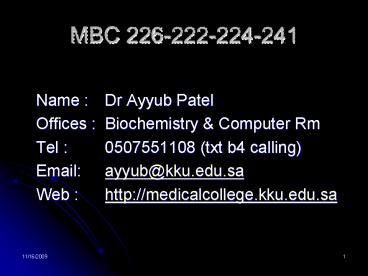MBC 226222224241 - PowerPoint PPT Presentation
1 / 27
Title:
MBC 226222224241
Description:
read ahead in the text (Harper txtbook 25 or 26th edition ... 1 angstrom = 0.1 nm. 9/17/09. 11. Most abundant, essential for all organisms: C, N, O, P, S, H ... – PowerPoint PPT presentation
Number of Views:26
Avg rating:3.0/5.0
Title: MBC 226222224241
1
MBC 226-222-224-241
- Name Dr Ayyub Patel
- Offices Biochemistry Computer Rm
- Tel 0507551108 (txt b4 calling)
- Email ayyub_at_kku.edu.sa
- Web http//medicalcollege.kku.edu.sa
2
How to be successful in MBC
- come to class!!!
- read ahead in the text (Harper txtbook 25 or 26th
edition - dont fall behind
- understand the material
- memorize structures and pathways
- study in groups
- see me for help during office hours
3
College of Medicine Medical Sciences
Introduction Biochemistry?
- What is Biochemistry
- The Aim and Objective of Biochemistry
- Why Biochemistry
- Biomolecules Biochemical Methods
- Summary
? Harper 25th - Edition Pages 1-14
4
College of Medicine Medical Sciences
What is Biochemistry
- Bio - Life
- Chemistry - Science concerned with molecules
and their reactions - Biochemistry is the chemistry of Life
5
College of Medicine Medical Sciences
Aim of Biochemistry
- To Understand all the chemical processes
associated with living cells - To Isolate the various molecules and determine
their structure and function - To Understand how life began
6
College of Medicine Medical Sciences
Why Biochemistry For Medical Students
- All Diseases are a result of abnormalities of
molecules, chemical reactions and processes - Medical Professionals should know the normal
situation so that abnormalities can be quickly
diagnosed, prognosis of the symptoms can be
drafted leading to successful treatment of the
illness. - Major advances in biochemistry and molecular
biology has allowed diagnosis and treatment of
many diseases. Eg. Gene therapy
7
Principle Areas of Biochemistry
- Structure and function of biological
macromolecules - Metabolism anabolic and catabolic processes.
- Molecular Genetics How life is replicated.
Regulation of protein synthesis
8
College of Medicine Medical Sciences
Biomolecules
- Body is composed of a few elements that combine
to form many molecules (C, H, N, O, Ca, P, K, Na,
S, Cl, Mg, Fe, Mn, I) - Major complex molecules (Proteins, Polysacharides
(carbohydrates), Lipids, DNA, RNA) - The Human body has the following major
constituents - Proteins (17), Fat (14), Carbohydrates (2),
Water (62), Minerals (6). ((w/w)
9
Organization of Life
- elements
- simple organic compounds (monomers)
- macromolecules (polymers)
- supramolecular structures
- organelles
- cells
- tissues
- organisms
10
Range of the sizes of objects studies by
Biochemist and Biologist
1 angstrom 0.1 nm
11
Elements of Life
Most abundant, essential for all organisms C, N,
O, P, S, H Less abundant, essential for all
organisms Na, Mg, K, Ca, Cl Trace levels,
essential for all organism Mn, Fe, Co, Cu,
Zn Trace levels, essential for some organisms V,
Cr, Mo, B, Al, Ga, Sn, Si, As, Se, I,
12
Important compounds, functional groups
13
Many Important Biomolecules are Polymers
lipids
proteins
carbo
nucleic acids
monomer
polymer
supramolecular structure
14
Lipids
15
Proteins
16
Nucleic Acids
monomer
polymer
supramolecular structure
17
Prokaryote Cell
18
Cellular Organization of an E. coli Cell
200 300 mg protein / mL cytoplasm
19
Eukaryote Cell
20
(No Transcript)
21
(No Transcript)
22
(No Transcript)
23
College of Medicine Medical Sciences
The Cell
24
College of Medicine Medical Sciences
Biochemical Methods
- 3 Major Processes
- (1) Isolation
- (2) Determination of Structure
- (3) Analysis
25
College of Medicine Medical Sciences
Biochemical Methods
26
College of Medicine Medical Sciences
Biochemical Methods
27
College of Medicine Medical Sciences
Summary
- Elements such as C, H, N, O, etc. combine to
form biomolecules such as proteins, lipids,
carbohydrates, DNA and RNA. - Isolation and analysis using various techniques
allow diagnosis of malfunction and subsequently
proper treatment of diseases































